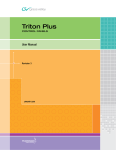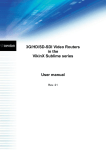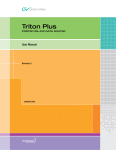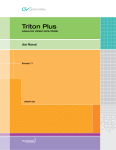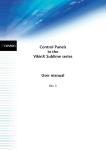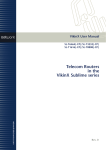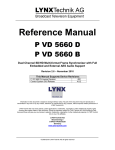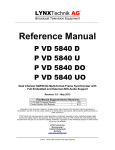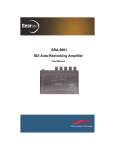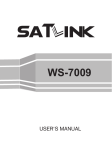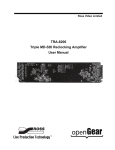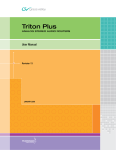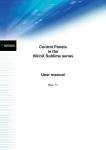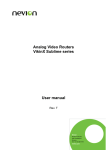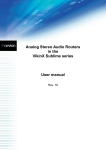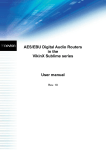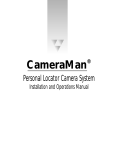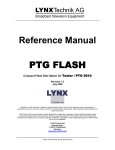Download Triton Plus - Grass Valley
Transcript
Triton Plus SD/3G-HD/HD VIDEO ROUTERS User Manual Revision 14 JANUARY 2009 Affiliate with the N.V. KEMA in The Netherlands CERTIFICATE Certificate Number: 510040.001 The Quality System of: Grass Valley, Inc. 400 Providence Mine Road Nevada City, CA 95945 United States 15655 SW Greystone Ct. Beaverton, OR 97006 United States 10 Presidential Way rd 3 Floor, Suite 300 Woburn, MA 01801 United States Nederland B.V. 4800 RP BREDA The Netherlands Weiterstadt, Germany Brunnenweg 9 D-64331 Weiterstadt Germany Rennes, France Rue du Clos Courtel Cesson-Sevigne, Cedex France Technopole Brest Iroise CS 73808 29238 Brest Cedex 3 France 17 rue du Petit Albi-BP 8244 95801 Cergy Pontoise Cergy, France 2300 South Decker Lake Blvd. Salt Lake City, UT 84119 United States 7140 Baymeadows Way Suite 101 Jacksonville, FL 32256 United States Including its implementation, meets the requirements of the standard: ISO 9001:2000 Scope: The design, manufacture and support of video hardware and software products and related systems. This Certificate is valid until: This Certificate is valid as of: Certified for the first time: June 14, 2009 August 30, 2006 June 14, 2000 H. Pierre Sallé President KEMA-Registered Quality The method of operation for quality certification is defined in the KEMA General Terms And Conditions For Quality And Environmental Management Systems Certifications. Integral publication of this certificate is allowed. KEMA-Registered Quality, Inc. 4377 County Line Road Chalfont, PA 18914 Ph: (215)997-4519 Fax: (215)997-3809 CRT 001 073004 Accredited By: ANAB Triton Plus SD/3G-HD/HD VIDEO ROUTERS User Manual Revision 14 JANUARY 2009 Contacting Grass Valley International France +800 8080 2020 or +33 1 48 25 20 20 United States/Canada Support Centers 24 x 7 +800 8080 2020 or +33 1 48 25 20 20 24 x 7 Asia +1 800 547 8949 or +1 530 478 4148 Hong Kong, Taiwan, Korea, Macau: +852 2531 3058 Indian Subcontinent: +91 22 24933476 Southeast Asia/Malaysia: +603 7805 3884 Southeast Asia/Singapore: +65 6379 1313 China: +861 0660 159 450 Japan: +81 3 5484 6868 Local Support Australia and New Zealand: +61 1300 721 495 Central/South America: +55 11 5509 3443 Centers (available Middle East: +971 4 299 64 40 Near East and Africa: +800 8080 2020 or +33 1 48 25 20 20 during normal Belarus, Russia, Tadzikistan, Ukraine, Uzbekistan: +7 095 2580924 225 Switzerland: +41 1 487 80 02 business hours) S. Europe/Italy-Roma: +39 06 87 20 35 28 -Milan: +39 02 48 41 46 58 S. Europe/Spain: +34 91 512 03 50 Europe Benelux/Belgium: +32 (0) 2 334 90 30 Benelux/Netherlands: +31 (0) 35 62 38 42 1 N. Europe: +45 45 96 88 70 Germany, Austria, Eastern Europe: +49 6150 104 444 UK, Ireland, Israel: +44 118 923 0499 Copyright © Thomson. All rights reserved. This product may be covered by one or more U.S. and foreign patents. Grass Valley Web Site The www.thomsongrassvalley.com web site offers the following: Online User Documentation — Current versions of product catalogs, brochures, data sheets, ordering guides, planning guides, manuals, and release notes in .pdf format can be downloaded. FAQ Database — Solutions to problems and troubleshooting efforts can be found by searching our Frequently Asked Questions (FAQ) database. Software Downloads — Download software updates, drivers, and patches. 4 Triton Plus - SD/3G-HD/HD - User Manual Contents Triton Plus SD/3G-HD/HD Video Routers . . . . . . . . . . . . . . . . . . . . . . . . . . . . . . . . 7 Product Overview . . . . . . . . . . . . . . . . . . . . . . . . . . . . . . . . . . . . . . . . . . . . . . . . . . . . . . 7 Product Versions . . . . . . . . . . . . . . . . . . . . . . . . . . . . . . . . . . . . . . . . . . . . . . . . . . . . . 8 Connection Details . . . . . . . . . . . . . . . . . . . . . . . . . . . . . . . . . . . . . . . . . . . . . . . . . . . . 11 Power Supply Pinouts . . . . . . . . . . . . . . . . . . . . . . . . . . . . . . . . . . . . . . . . . . . . . . . 12 Configuration. . . . . . . . . . . . . . . . . . . . . . . . . . . . . . . . . . . . . . . . . . . . . . . . . . . . . . . . . 13 Router Level . . . . . . . . . . . . . . . . . . . . . . . . . . . . . . . . . . . . . . . . . . . . . . . . . . . . . . . . 13 Router Mode. . . . . . . . . . . . . . . . . . . . . . . . . . . . . . . . . . . . . . . . . . . . . . . . . . . . . . . . 14 Router Mode on NxN Square Routers . . . . . . . . . . . . . . . . . . . . . . . . . . . . . . . . 14 Power Alarm . . . . . . . . . . . . . . . . . . . . . . . . . . . . . . . . . . . . . . . . . . . . . . . . . . . . . . . 23 Power-up Mode . . . . . . . . . . . . . . . . . . . . . . . . . . . . . . . . . . . . . . . . . . . . . . . . . . . . . 23 Configuring Output on Single Bus Panels. . . . . . . . . . . . . . . . . . . . . . . . . . . . . . . 23 LED Status Indication. . . . . . . . . . . . . . . . . . . . . . . . . . . . . . . . . . . . . . . . . . . . . . . . . . 24 Start Up . . . . . . . . . . . . . . . . . . . . . . . . . . . . . . . . . . . . . . . . . . . . . . . . . . . . . . . . . . . . 24 Alarm States . . . . . . . . . . . . . . . . . . . . . . . . . . . . . . . . . . . . . . . . . . . . . . . . . . . . . . . . 24 Router Communication . . . . . . . . . . . . . . . . . . . . . . . . . . . . . . . . . . . . . . . . . . . . . . . . 25 Serial Connection. . . . . . . . . . . . . . . . . . . . . . . . . . . . . . . . . . . . . . . . . . . . . . . . . . . . 25 Maximum Cable Length (RS-232) . . . . . . . . . . . . . . . . . . . . . . . . . . . . . . . . . . . . 26 NCB Connection . . . . . . . . . . . . . . . . . . . . . . . . . . . . . . . . . . . . . . . . . . . . . . . . . . . . 26 Connecting Control Panels . . . . . . . . . . . . . . . . . . . . . . . . . . . . . . . . . . . . . . . . . . 26 Pinout and Cable Type . . . . . . . . . . . . . . . . . . . . . . . . . . . . . . . . . . . . . . . . . . . . . 26 Termination Plug . . . . . . . . . . . . . . . . . . . . . . . . . . . . . . . . . . . . . . . . . . . . . . . . . . 27 Control Bus Structure . . . . . . . . . . . . . . . . . . . . . . . . . . . . . . . . . . . . . . . . . . . . . . 28 Maximum Distance Between NCB Devices . . . . . . . . . . . . . . . . . . . . . . . . . . . . 28 Connecting Signal Cables to the Triton Plus Router . . . . . . . . . . . . . . . . . . . . . . . . 28 Video Signals . . . . . . . . . . . . . . . . . . . . . . . . . . . . . . . . . . . . . . . . . . . . . . . . . . . . . . . 28 Control Panel Operation . . . . . . . . . . . . . . . . . . . . . . . . . . . . . . . . . . . . . . . . . . . . . . . 29 Button Description . . . . . . . . . . . . . . . . . . . . . . . . . . . . . . . . . . . . . . . . . . . . . . . . . . 29 A/V Toggle. . . . . . . . . . . . . . . . . . . . . . . . . . . . . . . . . . . . . . . . . . . . . . . . . . . . . . . 29 Panel Enable . . . . . . . . . . . . . . . . . . . . . . . . . . . . . . . . . . . . . . . . . . . . . . . . . . . . . . 30 Take On/Off . . . . . . . . . . . . . . . . . . . . . . . . . . . . . . . . . . . . . . . . . . . . . . . . . . . . . . 30 Take . . . . . . . . . . . . . . . . . . . . . . . . . . . . . . . . . . . . . . . . . . . . . . . . . . . . . . . . . . . . . 30 Output . . . . . . . . . . . . . . . . . . . . . . . . . . . . . . . . . . . . . . . . . . . . . . . . . . . . . . . . . . . 30 Input. . . . . . . . . . . . . . . . . . . . . . . . . . . . . . . . . . . . . . . . . . . . . . . . . . . . . . . . . . . . . 30 Specifications . . . . . . . . . . . . . . . . . . . . . . . . . . . . . . . . . . . . . . . . . . . . . . . . . . . . . . . . . 31 T r i t o n P l u s - S D /3 G -H D /H D - U ser M a n u a l 5 Contents 6 Triton Plus - SD/3G-HD/HD - User Manual Triton Plus SD/3G-HD/HD Video Routers Product Overview Thomson Grass Valley is proud to present the second generation of the compact small and medium routing switcher family – Triton Plus. With Triton Plus, Thomson Grass Valley now provides a stable and proven product line including the most complete signal format and size offering available. With the new ultra-slim, multi-format and flexible product range, Triton Plus fulfils the most demanding requirements from the professional broadcast market. This User Manual presents the features listed below, installation and operation procedures of the SD and 3G HD/HD routers of the Triton Plus range. • Router range from 8x8 to 64x64 • RS-232 and NCB Control (RJ45) • Multi- single- and dual bus control panels • Ultra-slim frame depth • Low power, high reliability design • Redundant power supply system with front indicators • Interoperability with existing Triton Plus routers • Future-proof and flexible product range Triton Plus provides many of the powerful control features that drove the Triton Modular range to success. Triton Plus is ideal for general purpose facilities, on-air routing, mobile outside broadcast applications, and sophisticated A/V applications. Triton Plus - SD/3G-HD/HD -User Manual 7 Product Overview Product Versions The following versions of the Triton Plus SD/3G-HD/HD Video Routers are available: • SD Digital Video – 19 in., 1 RU, Depth - 5 cm (see Table 1) • SD Digital Video – 19 in., 2 RU, Depth - 5 cm (see Table 2) • SD Digital Video – 19 in., 4 RU, Depth - 5 cm (see Table 3) • 3G-HD/HD Digital Video – 19 in., 1 RU, Depth - 5 cm (see Table 4 on page 9) • 3G-HD/HD Digital Video – 19 in., 2 RU, Depth - 5 cm (see Table 5 on page 9) • 3G-HD/HD Digital Video – 19 in., 4 RU, Depth 5 - cm (see Table 6 on page 9) Table 1. SD Digital Video – 19 in., 1 RU, Depth - 5 cm Model Description TPS-SD0808-R / TPS-SD0808-R-CP 8x8 SD Digital Video Router (540Mbps). Router partitioning, reclocking, X-Y control panel (on CP version) TPS-SD0808-N / TPS-SD0808-N-CP 8x8 SD Digital Video Router (540Mbps), Router partitioning, non-reclocking, X-Y control panel (on CP version) TPS-SD1616-R / TPS-SD1616-R-CP 16x16 SD Digital Video Router (540Mbps), Router partitioning, reclocking, X-Y control panel (on CP version) TPS-SD1616-N / TPS-SD1616-N-CP 16x16 SD Digital Video Router (540Mbps). Router partitioning, non-reclocking, X-Y control panel (on CP version) TPS-SD1602-R / TPS-SD1602-R-CP 16x2 SD Digital Video Router (540Mbps). Reclocking Dual bus control panel (on CP version) Table 2. SD Digital Video – 19 in., 2 RU, Depth - 5 cm Model Description TPS-SD3232-R / TPS-SD3232-R-CP 32x32 SD Digital Video Router (540 Mbps). Router partitioning, reclocking, X-Y control panel (on CP version) TPS-SD3232-N / TPS-SD3232-N-CP 32x32 SD Digital Video Router (540Mbps). Router partitioning, non-reclocking, X-Y control panel (on CP version) Table 3. SD Digital Video – 19 in., 4 RU, Depth - 5 cm Model 8 Description TPS-SD6464-R / TPS-SD6464-R-CP 64x64 SD Digital Video Router (540Mbps). Router partitioning, reclocking, X-Y control panel (on CP version) TPS-SD6464-N / TPS-SD6464-N-CP 64x64 SD Digital Video Router (540Mbps). Router partitioning, non-reclocking, X-Y control panel (on CP version) Triton Plus - SD/3G-HD/HD -User Manual Product Overview Table 4. 3G-HD/HD Digital Video – 19 in., 1 RU, Depth - 5 cm Model Description TPS-3GHD0808 / TPS-3GHD0808 -CP 8x8 HD Digital Video Router (Multirate, 270Mbps - 2.97Gbps). Router partitioning, reclocking, X-Y control panel (on CP version) TPS-3GHD1616 / TPS-3GHD1616 -CP 16x16 HD Digital Video Router (Multirate, 270Mbps - 2.97Gbps). Router partitioning, reclocking, X-Y control panel (on CP version) TPS-3GHD1602 / TPS-3GHD1602 -CP 16x2 HD Digital Video Router (Multirate, 270Mbps - 2.97Gbps). Reclocking, Dual bus control panel (on CP version) TPS-HD0808-N / TPS-HD0808-N-CP 8x8 HD Digital Video Router (1.5Gbps). Router partitioning, Non-reclocking, X-Y control panel (on CP version) TPS-HD1616-N / TPS-HD1616-N-CP 16x16 HD Digital Video Router (1.5Gbps). Router partitioning, Non-reclocking, X-Y control panel (on CP version) Table 5. 3G-HD/HD Digital Video – 19 in., 2 RU, Depth - 5 cm Model Description TPS-3GHD3232 / TPS-3GHD3232-CP 32x32 HD Digital Video Router (Multirate, 270Mbps - 2.97Gbps). Router partitioning, reclocking, X-Y control panel (on CP version) TPS-HD3232-N / TPS-HD3232-N-CP 32x32 HD Digital Video Router (1.5Gbps). Router partitioning, Non-reclocking, X-Y control panel (on CP version) Table 6. 3G-HD/HD Digital Video – 19 in., 4 RU, Depth - 5 cm Model Description TPS-3GHD6464 / TPS-3GHD6464 -CP 64x64 HD Digital Video Router (Multirate, 270Mbps - 2.97Gbps).Router partitioning, reclocking, X-Y control panel (on CP version) TPS-HD6464-N / TPS-HD6464-N-CP 64x64 HD Digital Video Router (1.5Gbps). Router partitioning, Non-reclocking, X-Y control panel (on CP version). Triton Plus - SD/3G-HD/HD -User Manual 9 Product Overview The following control panel versions are available for the Triton Plus series: • 19 in. 1 RU (Table 7) • 19 in. 2 RU (Table 8) • 19 in. 4 RU (Table 9) Table 7. 19 in. 1 RU Control Panels Control Panel Model Descriptions TPS-16XY-CP Multi bus X-Y 16x16 panel TPS-8XY-CP Multi bus X-Y 8x8 panel TPS-16D-CP Dual bus 16x2 panel TPS-32S-CP Single bus 32x1 panel TPS-32S-CP-GPI Single bus 32x1 panel with GPI/Joystick/Tally interface TPS-16S-CP Single bus 16x1 panel TPS-16S-CP-GPI Single bus 16x1 panel with GPI/Joystick/Tally interface TPS-8S-CP Single bus 8x1 panel TPS-8S-CP-GPI Single bus 8x1 panel with GPI/Joystick/Tally interface TPS-16XY-CP Multi bus X-Y 16x16 panel Table 8. 19 in. 2 RU Control Panels Control Panel Model Descriptions TPS-32XY-CP Multi bus X-Y 32x32 panel TPS-64S-CP Single bus 64x1 panel TPS-64S-CP-GPI Single bus 64x1 panel with GPI/Joystick/Tally interface Table 9. 19 in. 4 RU Control Panels 10 Control Panel Model Descriptions TPS-64XY-CP Multi bus X-Y 64x64 panel Triton Plus - SD/3G-HD/HD -User Manual Connection Details Connection Details Available connectors at the back panel of the Triton Plus Routers are shown in Figure 1. Note Figure 1 shows a 1 RU Triton Plus router. However, the connectors are identical to the 1 RU also on the 2 RU and 4 RU units. The only connectors that differ are the applicable signal connectors. Figure 1. Triton Router Connectors • SYNC: Synchronization signal (in). Black burst/composite/tri-level sync reference input with passive loop-through for vertical interval switching. • LOOP: Synchronization signal (out). Loop-through of SYNC input. • NCB IN: Network Control Bus Input. The protocol of this bus is equal, and compatible to the MIDI bus protocol. • NCB OUT: Network Control Bus Output. • ETHERNET: Not supported at this time. • RS-232: RS-232 for external control protocols. • POWER A: ±15VDC Power Input. • POWER B: ±15VDC Power Input, redundant supply. • CONFIGURATION: Configuration switches (8 pcs). Triton Plus - SD/3G-HD/HD -User Manual 11 Connection Details Power Supply Pinouts The DB9 power pinouts for Triton Plus routers and Control Panels are given in Table 10. Table 10. Power Supply Pinouts 12 Pin Number Description 1 Gnd 2 Not Connected 3 Not Connected 4 +15 VDC 5 Not Connected 6 Not Connected 7 Not Connected 8 -15 VDC 9 Not Connected Triton Plus - SD/3G-HD/HD -User Manual Configuration Configuration In order to get an overview of the parts that form the Triton Plus SD/HD Video Router, this section highlights some of the main components. Router Level Switches 1-4 on the configuration switch set the router’s level for communication with the Router Management System and other units in the NCB system. The panels on the NCB dedicated to operate with the router must be configured to the same level as that router. If several routers are combined to form an Audio Follow Video, RGB or similar system, these routers must be configured to the same level. The levels can be switched according to the patterns given in Table 11. The default level is 1. Table 11. Level Switch Patterns SW 1 SW 2 SW 3 SW 4 Level NCB Address Off Off Off Off 1 0 Off Off Off On 2 1 Off Off On Off 3 2 Off Off On On 4 3 Off On Off Off 5 4 Off On Off On 6 5 Off On On Off 7 6 Off On On On 8 7 On Off Off Off 9 8 On Off Off On 10 9 On Off On Off 11 10 On Off On On 12 11 On On Off Off 13 12 On On Off On 14 13 On On On Off 15 14 On On On On 16 15 Triton Plus - SD/3G-HD/HD -User Manual 13 Configuration Router Mode Router Mode on NxN Square Routers The Triton Plus A/V router allows switching in different modes. For a 1 RU Triton Plus router you can choose among the modes given in Table 12. Table 12. 1 RU Triton Plus Modes Router Layers 8x8 Router 16x16 Router 1 layer 8x8 16x16 2 layers 4x4 8x8 3 layers N/A 5x5 4 layers 2x2 4x4 For a 2 RU Triton Plus router you can choose among the modes given in Table 13. Table 13. 2 RU Triton Plus Modes Router Layers 32x32 Router 1 layer 32x32 2 layers 16x16 3 layers 10x10 4 layers 8x8 For a 4 RU Triton Plus router you can choose among the modes given in Table 14. Table 14. 4 RU Triton Plus Modes 14 Router Layers 32x32 Router 1 layer 64x64 2 layers 32x32 3 layers 21x21 4 layers 16x16 Triton Plus - SD/3G-HD/HD -User Manual Configuration Switches 5 - 6 on the configuration switch set the router’s mode. The Router Management System software must be configured according to the mode chosen on the router. The default mode is 1 router layer (SW 5 and SW 6 off). The modes can be switched according to the pattern given in Table 15. Table 15. SW 5 and SW 6 Router Modes SW 5 SW 6 Router Mode Off Off 1 router layer Off On 2 router layers On Off 3 router layers On On 4 router layers Based on the configuration above, the I/O is connected to the router according to the following schemes in Table 16 through Table 27 where the physical limitations depend on the type of router that is purchased (8x8, 16x16, 32x32, or 64x64). Each table title identifies the number of router layers based on the router type: Table 16. 1 Router Layer Signal Input Signal Output 1 1 1 1 2 2 2 2 3 3 3 3 4 4 4 4 5 5 5 5 6 6 6 6 7 7 7 7 8 8 8 8 ... ... ... ... 16 16 16 16 17 17 17 17 ... ... ... ... 32 32 32 32 33 33 33 33 ... ... ... ... 64 64 64 64 Triton Plus - SD/3G-HD/HD -User Manual 15 Configuration Table 17. 2 Router Layers Based on an 8x8 Router Layer 1 Input Layer 1 Output 1 1 1 1 2 2 2 2 3 3 3 3 4 4 4 4 Layer 2 Input Layer 2 Output 1 5 1 5 2 6 2 6 3 7 3 7 4 8 4 8 Table 18. 2 Router Layers Based on an 16x16 Router 16 Layer 1 Input Layer 1 Output 1 1 1 1 2 2 2 2 3 3 3 3 4 4 4 4 5 5 5 5 6 6 6 6 7 7 7 7 8 8 8 8 Layer 2 Input Layer 2 Output 1 9 1 9 2 10 2 10 3 11 3 11 4 12 4 12 5 13 5 13 6 14 6 14 7 15 7 15 8 16 8 16 Triton Plus - SD/3G-HD/HD -User Manual Configuration Table 19. 2 Router Layers Based on an 32x32 Router Layer 1 Input Layer 1 Output 1 1 1 1 2 2 2 2 3 3 3 3 ... ... ... ... 8 8 8 8 ... ... ... ... ... ... ... ... 16 16 16 16 Layer 2 Input Layer 2 Output 1 17 1 17 2 18 2 18 3 19 3 19 ... ... ... ... 8 24 8 24 9 25 9 25 ... ... ... ... 16 32 16 32 Table 20. 2 Router Layers Based on an 64x64 Router Layer 1 Input Layer 1 Output 1 1 1 1 2 2 2 2 3 3 3 3 ... ... ... ... 16 16 16 16 ... ... ... ... ... ... ... ... 32 32 32 32 Layer 2 Input Layer 2 Output 1 33 1 33 2 34 2 34 3 35 3 35 ... ... ... ... 16 48 16 48 17 49 17 49 ... ... ... ... 32 64 32 64 Triton Plus - SD/3G-HD/HD -User Manual 17 Configuration Table 21. 3 Router Layers Based on an 16x16 Router Layer 1 Input Layer 1 Output 1 1 1 1 2 2 2 2 3 3 3 3 4 4 4 4 5 5 5 5 Layer 2 Input Layer 2 Output 1 6 1 6 2 7 2 7 3 8 3 8 4 9 4 9 5 10 5 10 Layer 3 Input Layer 3 Output 1 11 1 11 2 12 2 12 3 13 3 13 4 14 4 14 5 15 5 15 Table 22. 3 Router Layers Based on an 32x32 Router Layer 1 Input Layer 1 Output 1 1 1 1 2 2 2 2 3 3 3 3 ... ... ... ... 10 10 10 10 Layer 2 Input Layer 2 Output 1 11 1 11 2 12 2 12 3 13 3 13 ... ... ... ... 10 20 10 20 Layer 3 Input Layer 3 Output 1 21 1 21 2 22 2 22 3 23 3 23 ... ... ... ... 10 301 10 1 18 30 1 Inputs/Outputs 31 and 32 are not used in this setup. Triton Plus - SD/3G-HD/HD -User Manual Configuration Table 23. 3 Router Layers Based on an 64x64 Router 1 Layer 1 Input Layer 1 Output 1 1 1 1 2 2 2 2 3 3 3 3 ... ... ... ... 21 21 21 21 Layer 2 Input Layer 2 Output 1 22 1 22 2 23 2 23 3 24 3 24 ... ... ... ... 21 42 21 42 Layer 3 Input Layer 3 Output 1 43 1 43 2 44 2 44 3 45 3 45 ... ... ... ... 21 631 21 631 Input/Output 64 is not used in this setup. Table 24. 4 Router Layers Based on an 8x8 Router Layer 1 Input Layer 1 Output 1 1 1 1 2 2 2 2 Layer 2 Input Layer 2 Output 1 3 1 3 2 4 2 4 Layer 3 Input Layer 3 Output 1 5 1 5 2 6 2 6 Layer 4 Input Layer 4 Output 1 7 1 7 2 8 2 8 Triton Plus - SD/3G-HD/HD -User Manual 19 Configuration Table 25. 4 Router Layers Based on an 16x16 Router 20 Layer 1 Input Layer 1 Output 1 1 1 1 2 2 2 2 3 3 3 3 4 4 4 4 Layer 2 Input Layer 2 Output 1 5 1 5 2 6 2 6 3 7 3 7 4 8 4 8 Layer 3 Input Layer 3 Output 1 9 1 9 2 10 2 10 3 11 3 11 4 12 4 12 Layer 4 Input Layer 4 Output 1 13 1 13 2 14 2 14 3 15 3 15 4 16 4 16 Triton Plus - SD/3G-HD/HD -User Manual Configuration Table 26. 4 Router Layers Based on an 32x32 Router Layer 1 Input Layer 1 Output 1 1 1 1 2 2 2 2 ... ... ... ... 8 8 8 8 Layer 2 Input Layer 2 Output 1 9 1 9 2 10 2 10 ... ... ... ... 8 16 8 16 Layer 3 Input Layer 3 Output 1 17 1 17 2 18 2 18 ... ... ... ... 8 24 8 24 Layer 4 Input Layer 4 Output 1 25 1 25 2 26 2 26 ... ... ... ... 8 32 8 32 Triton Plus - SD/3G-HD/HD -User Manual 21 Configuration Table 27. 4 Router Layers Based on an 64x64 Router 22 Layer 1 Input Layer 1 Output 1 1 1 1 2 2 2 2 ... ... ... ... 16 16 16 16 Layer 2 Input Layer 2 Output 1 17 1 17 2 18 2 18 ... ... ... ... 16 32 16 32 Layer 3 Input Layer 3 Output 1 33 1 33 2 34 2 34 ... ... ... ... 16 48 16 48 Layer 4 Input Layer 4 Output 1 49 1 49 2 50 2 50 ... ... ... ... 16 64 16 64 Triton Plus - SD/3G-HD/HD -User Manual Configuration Power Alarm The power alarm can be switched with switch SW 7 according to the pattern given in Table 28. The default setting is power alarm disabled. Table 28. SW 7 – Power Alarm SW 7 Power Alarm Off Disables power alarm On Enables power alarm Power-up Mode Switch SW 8 on the configuration switch defines the power up mode on NxN square routers, and enables input extension on 16x2 routers. The Triton Plus router provides two modes for powering up the system. The power up options can be switched according to the following pattern given in Table 29: Table 29. SW 8 – Power Up Mode SW 8 Power Up Mode Off Switches all outputs according to the buffered information in the routers processor system. On Switches all outputs to input 1. Default setting switches all outputs according to the buffered information in the routers processor system. Configuring Output on Single Bus Panels Refer to Input on page 30 for configuring default output to be controlled from a single bus control panel. Triton Plus - SD/3G-HD/HD -User Manual 23 LED Status Indication LED Status Indication Start Up The LED located at the front of the router indicates the status of the router. At start-up, the LED will alternate between red (R) and green (G) every 500ms for about two seconds. After the start-up sequence the LED will indicate the Alarm state of the router. Alarm States The LED can either be red (R), green (G), or have no light (N). The LED state is described in Table 30 below with twenty letters, each representing 100ms, which totals an alarm sequence of two seconds. The X indicates that the LED keeps the color it has the moment the alarm sequence begins (green or no light). Table 30. LED Alarm States Description 24 LED State Alarm Continuous Green Light GGGGG GGGGG GGGGG GGGGG No Alarm Status OK Long Red Blinking RRRRR NNNNN RRRRR NNNNN Power is too low One Short Red Blink RXXXX XXXXX XXXXX XXXXX Power A failed Two Short Red Blinks XXXXX XXXXX RXRXX XXXXX Power B failed Comment Only active if power alarm DIP is set. Triton Plus - SD/3G-HD/HD -User Manual Router Communication Router Communication You gain access to router for communication purposes by connecting the router’s serial port to your computer. Serial Connection Connection can by made trough the serial port(s) of the router; see also Connection Details on page 11 for connection details. The communication parameters are configurable. Please refer to the protocol documentation of the appropriate communication/control protocol. Example: The protocol parameters of the Triton Plus Compact routers are as follows: • Bit rate 19200 bit/s • Data bits 8 bits • Stop bits 1 • Parity: No parity For further detail concerning this protocol, please refer to the following manual: Compact Router Control Protocol. The DB9 female connector for the serial port(s) of the router has the following pinout (Table 31): Table 31. Serial Connection Pinout Note Pin # RS-232 Mode 1 Not in use 2 Tx 3 Rx 4 Not in use 5 GND 6 GND 7 RTS 8 CTS 9 Do Not Connect! If the standard RS-232 cable specification (DCE) is followed: A cable with Male+Male or Female+Female connectors at the cable ends is used for Rx/Tx crossed connection. A cable with Male+Female connectors at the cable ends is used for a straight through connection. Triton Plus - SD/3G-HD/HD -User Manual 25 Router Communication Maximum Cable Length (RS-232) IEEE has specified the maximum cable length for an RS-232 connection to 15m. Longer distances can be installed depending on the environmental conditions of the installation site. It is the responsibility of the installer/user to secure a proper installation of the RS-232 connection. NCB Connection Via the Network Control Bus system, several routers and control panels can be interconnected. Up to 16 levels of routers, or combinations of routers, can be controlled. The NCB system and all RS-232 ports interchange the system status. This means that any control system, either from Grass Valley, or from a third party manufacturer, connected to any RS-232 port in the NCB loop, will have access to all communication data on the bus. Connecting Control Panels To get a control panel working with a specific router, configure the control panel to the same level as the router. Several panels can be configured to control the same router. Panels can also be connected to a router via the RS 232 interface. Please refer to your control panel manual for installation. Pinout and Cable Type Triton Plus routers and Control Panels use RJ45 connectors for the Network Control Bus ports. The following pinout shown in Table 32 is used: Table 32. RJ45 Connector Pinouts 26 Pin # Description 1 Not Connected 2 Not Connected 3 Data (retour) 4 Data 5 Data 6 Data (retour) 7 Not Connected 8 Not Connected Illustration Triton Plus - SD/3G-HD/HD -User Manual Router Communication The following connection example (Figure 2) shows connection of four Triton Plus devices with RJ45 connectors and bus termination: Figure 2. Four Devices Connected Together Using RJ45 Note Each device at the end of the chain has a termination plug, indicated with the letter T. This termination plug must be inserted in the correct connection port. If not, no NCB communication is possible. Termination Plug The termination plug that is mentioned in the previous chapter is necessary when you want to avoid closing the loop with a (long) cable. The termination plug is a standard RJ45 plug with the following internal wiring shown in Figure 3. Figure 3. RJ45 Termination Plug Wiring Pin 3 is connected to Pin 4 Triton Plus - SD/3G-HD/HD -User Manual Pin 5 is connected to Pin 6 27 Connecting Signal Cables to the Triton Plus Router Control Bus Structure The Network Control Bus structure follows the standard MIDI bus definition. The NCB is defined as a closed chain of units. This means that the NCB OUT of the last unit must be connected to the NCB IN of the first unit in the NCB chain. To avoid problems with the control of Triton Plus units the installer/user has to assure that the bus structure is installed according to this definition. Note The total number of Triton Plus devices in an NCB chain is limited to 50. Maximum Distance Between NCB Devices The standard MIDI definition allows a maximum cable length of 200-250 meters between two devices. Longer distances can be made with MIDI repeater units. To avoid grounding problems all NCB ports have opto-coupled inputs. Connecting Signal Cables to the Triton Plus Router Video Signals The Triton Plus Video Router offers standard 75 ohm BNC connectors for video inputs and outputs. All video inputs are terminated with 75 ohm terminations. 28 Triton Plus - SD/3G-HD/HD -User Manual Control Panel Operation Control Panel Operation Note This chapter is only applicable for routers with the optional local control panel. All local control panels are given a default configuration, which includes the buttons A/V Toggle, Panel Enable, Take On/Off, and Take. In addition, Input and Output buttons are pre-configured. Button Description A/V Toggle The A/V Toggle button enables/disables audio and video on a specified address. The address can either be read from the DIP switches or be fixed. The button toggles between three states. Note If the button is pressed for more than 1 second, it will go into a fourth state where both audio and video are disabled. In this state the button will be dimmed. If the button is pressed for more than 1 second again, it will enable both audio and video if present. Refer to Table 33. Table 33. A/V Toggle Button Button Color Video Enabled Audio Enabled Yellow Yes Yes Green Yes No Red No Yes Dimmed No No If neither audio nor video is present, it will be marked as disabled and the toggle state will not be used. Toggle status changes will be stored in flash and used when the panel is powered up later. Triton Plus - SD/3G-HD/HD -User Manual 29 Control Panel Operation Panel Enable The panel will start up in a disabled state. In this state the button will be red and all the other buttons will be disabled. When pressing the button the panel will be enabled and the color will change to green. A status request will also be sent to get information on active levels. Take On/Off The Take On/Off button enables or disables the Take button. On first start-up the Take button is enabled. Later it will read the last status from the flash memory. Take The Take buttons LED is normally off. If the Take On/Off button is set to on, no commands will be sent from the panel until the Take button is pressed. The last selected buttons and the Take button will blink, until the Take button is pressed and the command is sent from the panel. Output An Output button is used for selecting an output. Selecting an output activates it, so that it is switched to the next input that is selected. Input An Input button switches the active output to the selected input. If the Take button is enabled, the switch will not be executed until the Take button is pressed. When switching using the Input button, all enabled audio- and video-levels will be switched from the selected input to the active output. Note 30 The Input button can also be used to select the active output. This is useful on single bus panels. When the panel is enabled, press the Panel Enable button and hold it while selecting the active output by pressing an Input button. Then release the Panel Enable button. The panel will now be disabled. Press the Panel Enable button again to enable it. Triton Plus - SD/3G-HD/HD -User Manual Specifications Specifications Note All specifications are subject to change without notice. Table 34. Triton Plus SD/3G-HD/HD Video Specifications Parameter Value SD Digital Video Supported Formats Broadcast • 143Mbps to 540Mbps • DVB ASI, SMPTE 259M Electrical Signal Inputs Standard SMPTE 259M Data rate 19Mbps and 143Mbps to 540Mbps Connector 75 ohm BNC female Impedance 75 ohm nominal Return loss >15dB, (5 to 540MHz Cable equalization (reclocked routers) 0 to 300m @270Mbps, typical Belden 8281 Cable equalization (non-reclocked routers) 0 to 200m @270Mbps, typical Belden 8281 Electrical Signal Outputs Connector 75 ohm BNC female Impedance 75 ohm nominal Return loss >15dB, (5 to 540MHz) Signal level 800mV p-p ±10% Rise/fall time • 20% to 80% • 0.4ns to 1.5ns, < 0.5ns rise/fall variation Amplitude overshoot < 10% Signal polarity Non-inverting electrical with respect to inputs Signal Transition Jitter < 0.2 UI, both timing and alignment jitter Reference Inputs Connector 75 ohm BNC female, loop-through Return loss • > 40dB (100kHz to 5MHz) • > 35dB (5 to 10MHz Signal format NTSC or PAL Black Burst Signal level Nominal 1.0V p-p Switching field Field 1 Timing • PAL: within clock intervals (27MHz) 565–835 in Line 6 • NTSC: within clock intervals (27MHz) 565–835 in Line 10 Triton Plus - SD/3G-HD/HD -User Manual 31 Specifications Table 34. Triton Plus SD/3G-HD/HD Video Specifications Parameter Value 3G-HD/HD Digital Video Supported formats Broadcast • 270Mbps to 2.97Gbps • DVB ASI, SMPTE 259M, SMPTE 292M, SMPTE 424M • 2X, 2048x1556/23.98 and 24 Electrical signal inputs Standard SMPTE 292M/SMPTE 424M Data rate 270Mbps to 1.485/2.97Gbps Connector 75 ohm BNC female Impedance 75 ohm nominal Return loss Cable equalization (reclocked routers) Cable equalization (non-reclocked routers) • > 15dB (5MHz to 1.485GHz) • > 10dB (1.5GHz to 3GHz) • 0 to 70m @2.97Gbps, typical Belden 1694A • 0 to 100m @1.485Gbps, typical Belden 1694A 0 to 25m @1.485Gbps, typical Belden 1694A Electrical Signal Outputs Connector 75 ohm BNC female Impedance 75 ohm nominal Return loss • >15dB, (5MHz to 1.485GHz) • > 10dB (1.5GHz to 3GHZ) Signal level Rise/fall time 800mV p-p ±10% 20% to 80% • SD limit: 0.4ns to 1.5ns, < 0.5ns rise/fall variation • HD limit: < 270ps, < 100ps rise/fall time • 3G-HD limit: < 135ps, < 50ps rise/fall variation Amplitude overshoot < 10% Signal polarity Non-inverting electrical with respect to inputs Signal Transition Timing jitter • SD: < 0.2 UI • 3G-HD/HD: < 1 UI Alignment jitter • SD: < 0.2 UI • 3G-HD/HD: < 0.2 UI Reference Inputs Connector 75 ohm BNC female, loop-through Return loss • > 40dB (100kHz to 5MHz) • > 35dB (5 to 10MHz 32 Signal format NTSC or PAL Black Burst or HD Tri-level according to SMPTE 274M, SMPTE 276M Signal level Nominal 1.0V p-p Switching field Field 1 Triton Plus - SD/3G-HD/HD -User Manual Specifications Table 34. Triton Plus SD/3G-HD/HD Video Specifications Parameter Timing Value • SD, PAL: within clock intervals (27MHz) 565–835 Line 6 • SD, NTSC: within clock intervals (27MHz) 565–835 Line 10 • HD Tri-level: 1280x720: within clock intervals (148.5MHz) 455–780 Line 7 • HD Tri-level: 1920x1080: with clock intervals (148.5Mhz) 625–1070 Line 7 Power Supply TPS-PWR-40 40W power supply unit for 8x8 to 32x32 TPS-PWR-90 90W power supply unit for 64x64 versions AC supply voltage range 100-240VAC, 50-60Hz max 1.6A (TPS-PWR-40)/max 3A (TPS-PWR-90) AC mains connector IEC 320 DC output • +15V, max. 2.2A/-15V, max 1.35A. Maximum 43W for 8x8–32x32 versions; • +15V, max. 4A/-15V, max 2.5A. Maximum 90W for 64x64 versions DC connector DB9, female Status monitoring Via LED in front of router/CP Control Standard Features Serial port RS-232 for protocol conversion, to Triton Plus compact control protocol, or to 3rd party protocols Connector DB9, female NCB ports For integration with Triton Plus compact router configuration Connectors (2) RJ45 (1 in/1 out) Ethernet 10/100BaseT Ethernet is not supported at this time Connector RJ45 Synchronization • Analog Black Burst, Looped; Both PAL and NTSC supported • Tri-level, Looped; For HD signal formats only • Distribution of synchronization signals between several routers Connector(s) BNC Optional Features Control panel • Optional, built-in control panel available • External control panels available Environmental Equipment will meet guaranteed performance specifications under the following conditions: Operating room temperature range 0º C to 45º C Operating relative humidity range < 95% (non-condensing) Equipment will operate without damage under the following conditions: Temperature range -10º C to 55º C Relative humidity range < 95% (non-condensing) Mechanical Dimensions • HxWxD = 44x483x50mm (19 in., 1 RU) • HxWxD = 88x483x50mm (19 in., 2 RU) • HxWxD = 176x483x50mm (19 in., 4 RU) Safety/Emission standards Triton Plus - SD/3G-HD/HD -User Manual Compliant with CE EN55103-1 and 2 33 Specifications 34 Triton Plus - SD/3G-HD/HD -User Manual


































